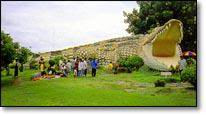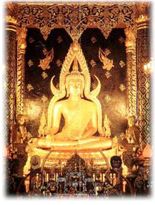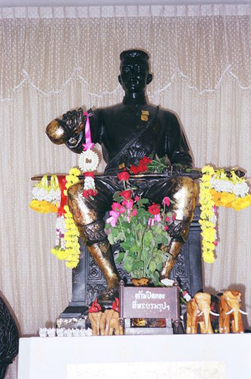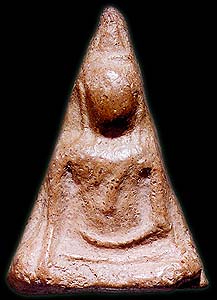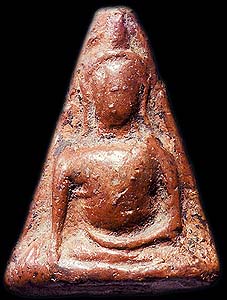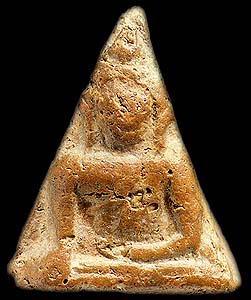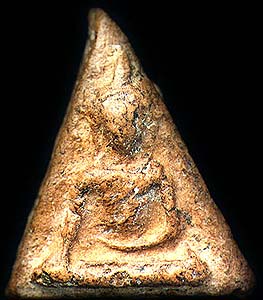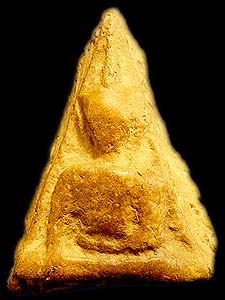
Mae Wong National Park is on the Thanon Thong Chai Mountain Range. The area consists of winding mountains and is the source of several waterways, including the Mae Wong River and some parts of Khlung Canal. The waterways flow into the Ping River and the Chao Phraya River. Mae Wong National Park is in Amphoe Pang Sila Thong in Kamphaeng Phet (446.4 square kilometers) and in Amphoe Mae Wong-Mae Poen in Nakhon Sawan (446.48 square kilometers), totaling 892.88 square kilometers. The north borders Khlong Lan National Park of Kamphaeng Phet, the south borders Huai Kha Khaeng Wildlife Reserve of Uthai Thani, the east borders villages in Kamphaeng Phet and Nakhon Sawan, and the west borders Um Phang Wildlife Reserve in Tak. The area was proclaimed a national park on 14 September 1987 and was the 55th national park of Thailand. The park headquarters are at No. 65, Khlong Lan-Um Phang Road, Amphoe Pang Sila Thong, Kamphaeng Phet.
Attractions in Mae Wong National Park :
Kaeng Pha Khoi Nang-Kaeng Nam Bon Kaeo Hin is on the Khlong Lan-Um Phang road and 1.4 kilometers from the park headquarters and another 400 meters on a secondary road. This is a large brook that Khlung Canal flows through. From here, you can walk around 350 meters to Pha Khoi Nang Waterfall that has 4 levels.
Viewpoint is on the Khlong Lan-Um Phang road at Km. 81, around 16 kilometers from the park headquarters. At Km. 93 about 28 kilometers from the headquarters is the area between mountains that is perpetually breezy with an average temperature below 20 degrees Celsius. It is 1.34 kilometers above sea level.
Nang Nuan Waterfall can be reached by getting to Km. 93 and going on foot for about 6.4 kilometers. The waterfall is located amidst the lush jungle. It has 4 levels. It takes about 1 day to make a return trip to the waterfall.
Mae Krasa Waterfall is a large 9-level waterfall about 900 meters high. The waterfall is formed by streams from high-altitude jungles on the Thanon Thong Chai Mountain Range. It is about 18 kilometers from the park headquarters. The trip on foot takes 3-4 days.
Mae Riwa Waterfall is around 21 kilometers from the headquarters. It is a large waterfall that has 5 levels and takes about 3 days for a return trip on foot.
Mokochu Peak is the highest peak in the park. It is 1.964 kilometers above sea level and is 50 kilometers from the headquarters. The return trip on foot takes 5-7 days.
Kaeng Lan Nok Yung is a brook with a wide rock plateau. Mae Wong River, which originates in Mae Wong Forest flows through it. It is about 800 meters from Mae Rewa Forest Protection Unit. The area is suitable for training programs and group camping. The distance from the unit to the brook is about 1.5 kilometers and it is accessible by car.
Moreover, there is accommodation in the park. For information, please contact Mae Wong National Park, Khlong Lan-Um Phang Road, Km. 65, Amphoe Khlong Lan, Kamphaeng Phet, tel. 0-5671-9010-1 or the National Parks Division, National Resources Conservation Office, Royal Forest Department, Bang Khen, Bangkok 10900, tel. 0-2579-0529, 0-2579-4843.
Getting There : There are 2 main routes:
1. Bangkok-Nakhon Sawan-Lat Yao-Khlong Lan route into the park on Highway No. 1117 (Khlong Lan-Um Phang) at Km. 65.
2. Bangkok-Nakhon Sawan-Khong Wilai-Khlong Lan route into the park on Highway No. 1117 (Khlong Lan-Um Phang). The total distance from Bangkok to the park is about 386 kilometers.

 Buddha built when Sukhothai was the countrys capital. The temple was praised by the Department of Religious Affairs as the best development temple of 1966. A nearby hill is the site of some television relay stations.
Buddha built when Sukhothai was the countrys capital. The temple was praised by the Department of Religious Affairs as the best development temple of 1966. A nearby hill is the site of some television relay stations. 







